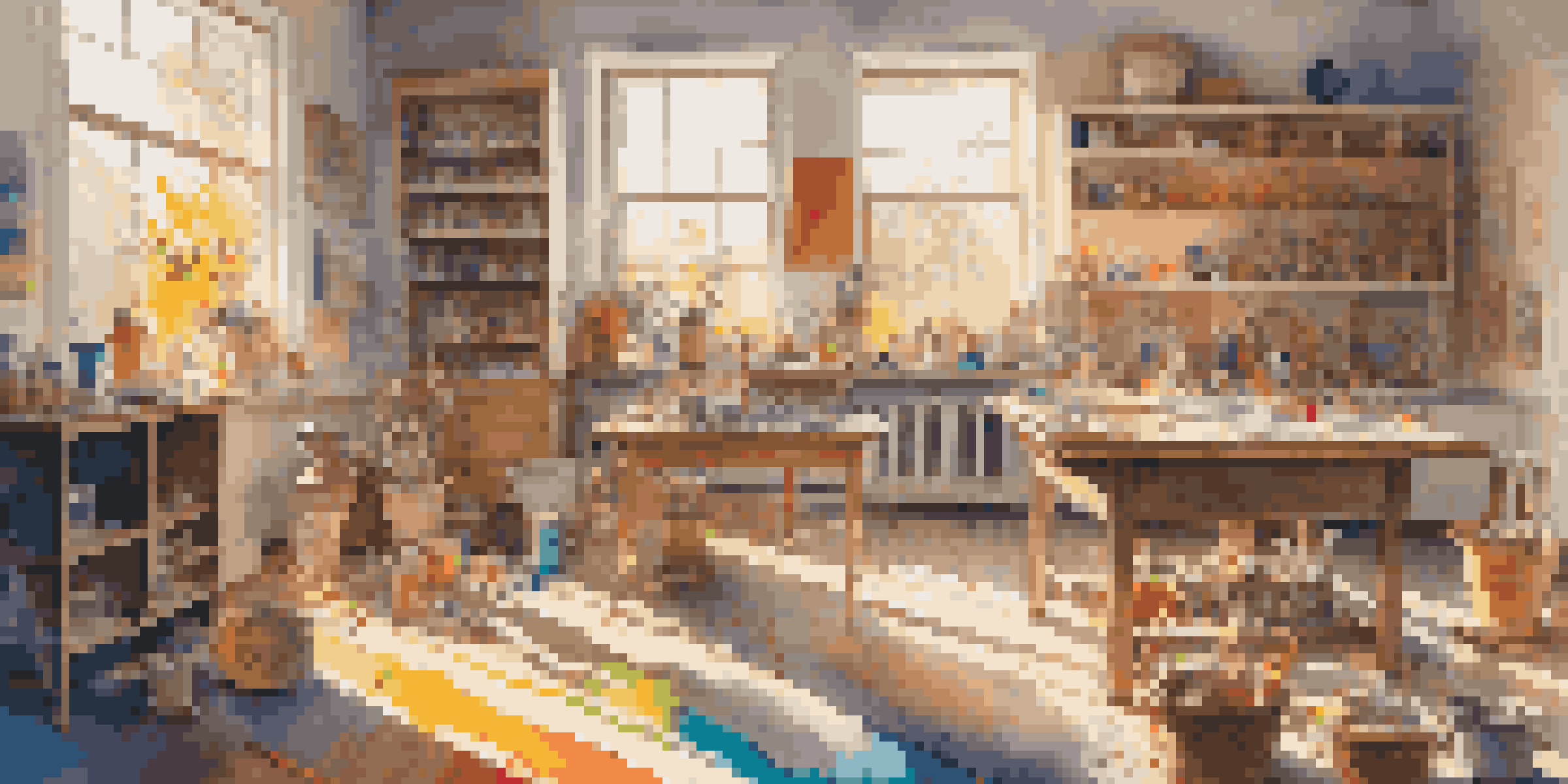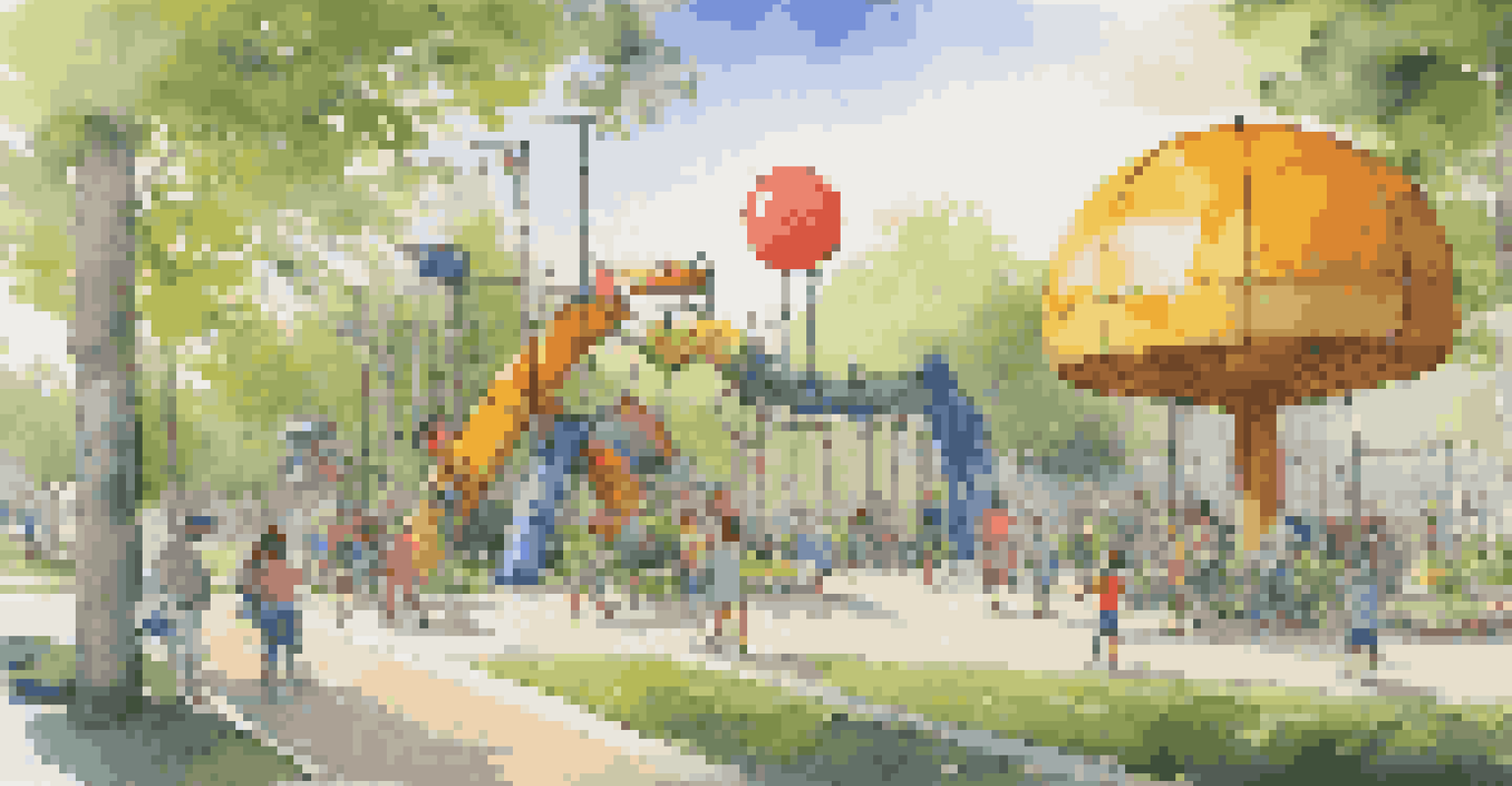Creating Joyful Experiences: The Role of Play in Art

Understanding the Essence of Play in Art
Play is often seen as a child's activity, but in the world of art, it serves a much deeper purpose. It allows artists to experiment freely, unhindered by the constraints of expectation or perfection. Just as children lose themselves in imaginative games, artists can tap into that same spirit of exploration to create something truly unique.
Every artist dips his brush in his own soul, and paints his own nature into his pictures.
When artists embrace play, they open themselves to spontaneity and new ideas. For instance, a painter might start with an abstract splash of color, letting the brush guide their hand rather than following a predetermined plan. This process can lead to unexpected and delightful outcomes, turning the act of creation into a joyful experience.
Moreover, playfulness in art encourages a sense of curiosity. It invites both the artist and the audience to engage with the work on a deeper level, sparking conversations and provoking thought. This interaction can transform simple viewing into an experience filled with wonder and excitement.
The Benefits of Playful Creativity
Engaging in playful creativity provides numerous benefits, both for artists and their audiences. It promotes mental flexibility, allowing individuals to think outside the box and approach problems with fresh perspectives. This kind of thinking not only enhances artistic expression but also nurtures innovation in other fields.

Additionally, play can serve as a powerful stress relief tool. Creating art without the pressure of perfection enables artists to relax and enjoy the process. This sense of freedom can lead to the production of more authentic and heartfelt work, resonating with viewers on an emotional level.
Play Fuels Artistic Exploration
Engaging in playful creativity allows artists to experiment freely, fostering spontaneity and unique outcomes.
Moreover, playful creativity fosters collaboration among artists. When individuals feel safe to explore and play, they are more likely to share ideas and build off one another’s work. This collaborative spirit can lead to vibrant communities where creativity thrives and new artistic movements emerge.
Incorporating Play into Artistic Practice
Incorporating play into artistic practice doesn't require a complete overhaul of one's routine. Simple changes can make a significant difference, such as setting aside time for unstructured exploration or using unconventional materials. For example, a sculptor might experiment with clay, allowing their hands to shape forms spontaneously.
Art is the most beautiful of all lies; it is the most beautiful of all lies because it is the most beautiful of all truths.
Another effective method is to engage in creative exercises that prioritize playfulness. Activities like doodling, collage-making, or even group brainstorming sessions can ignite inspiration. These exercises encourage artists to let go of their inhibitions and rediscover the joy of creation.
Lastly, artists can embrace playful themes in their work. By focusing on subjects that evoke happiness or nostalgia, they can connect more deeply with their audience. This approach not only enhances the enjoyment of the artwork but also reinforces the importance of play in the creative process.
The Impact of Play on Audience Engagement
The role of play extends beyond the artist to the audience, significantly impacting how they engage with art. Playful elements in artwork can invite viewers to interact, encouraging them to not just observe but also participate in the experience. This interaction can create memorable moments that resonate long after the initial viewing.
For instance, participatory installations that require audience involvement can transform passive observation into active engagement. When viewers feel like they are part of the art, their emotional connection deepens, leading to a more profound appreciation of the work. This sense of joy in participation can elevate the entire experience.
Play Enhances Audience Engagement
Playful elements in art invite audience interaction, creating memorable experiences that deepen emotional connections.
Furthermore, playful art can evoke nostalgia and spark joy, making it accessible to a broader audience. When people encounter art that feels lighthearted or whimsical, it encourages them to explore their own memories and emotions. This relatability can foster a sense of community around shared experiences and joyful interactions.
Art Therapy: Play as a Healing Tool
The therapeutic benefits of incorporating play into art are well-documented, especially in art therapy. This approach uses creative expression to help individuals process emotions, reduce anxiety, and improve mental health. Playful art-making allows participants to explore their feelings without the weight of judgment or expectation.
In art therapy sessions, individuals often engage in playful activities that encourage self-expression. Techniques such as spontaneous drawing or playful collage can unlock hidden emotions and foster healing. As participants immerse themselves in the creative process, they may find new ways to articulate their thoughts and feelings.
Furthermore, art therapy emphasizes the joy of creation as a pathway to wellness. Participants learn that the act of making art can be liberating and joyful, helping them reconnect with their inner child. This rediscovery of play can lead to profound personal insights and a greater sense of emotional balance.
Celebrating Playfulness in Artistic Communities
Art communities that embrace playfulness foster an environment where creativity can flourish. By celebrating playful experimentation, these communities encourage artists to take risks and push boundaries. This supportive atmosphere cultivates innovation and inspires individuals to explore new artistic directions.
Events such as collaborative art projects, workshops, and playful exhibitions can further enhance this sense of community. These gatherings provide opportunities for artists to connect, share ideas, and engage in playful exploration together. They create a vibrant network where creativity is nurtured and celebrated.
Art Therapy Utilizes Play for Healing
Incorporating play into art therapy helps individuals process emotions and improve mental well-being through creative expression.
Moreover, a playful approach can attract a diverse audience to the arts. When art is perceived as fun and engaging, it draws in people from various backgrounds and ages. This inclusivity enriches the community and promotes a shared appreciation for the joy that art can bring.
The Future of Play in Art
As the art world continues to evolve, the role of play remains crucial in shaping its future. With the rise of digital art and interactive installations, artists have more tools than ever to incorporate playful elements into their work. This evolution opens new avenues for creativity and engagement, inviting audiences to participate in ways they never thought possible.
Moreover, the growing emphasis on mental health and well-being highlights the importance of play in artistic practices. As more artists recognize the therapeutic benefits of playful expression, we may see a shift toward prioritizing joy and exploration in the creative process. This shift can enhance not only the quality of the art but also the overall experience for both artists and viewers.

Ultimately, embracing play in art can lead to a richer, more vibrant artistic landscape. By fostering joy, collaboration, and innovation, artists can create experiences that resonate meaningfully with their audiences. As we look to the future, let’s celebrate and nurture the playful spirit that makes art a joyful, transformative experience.